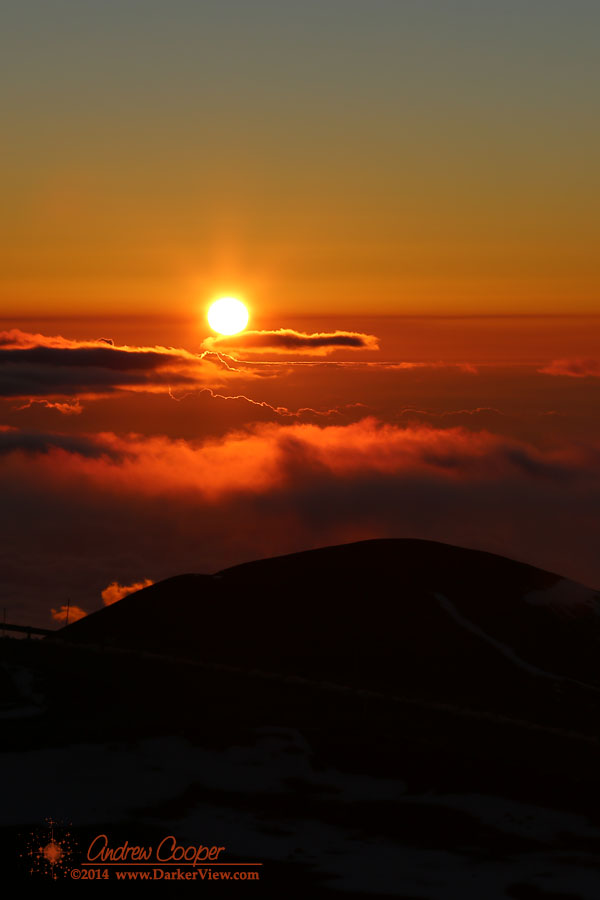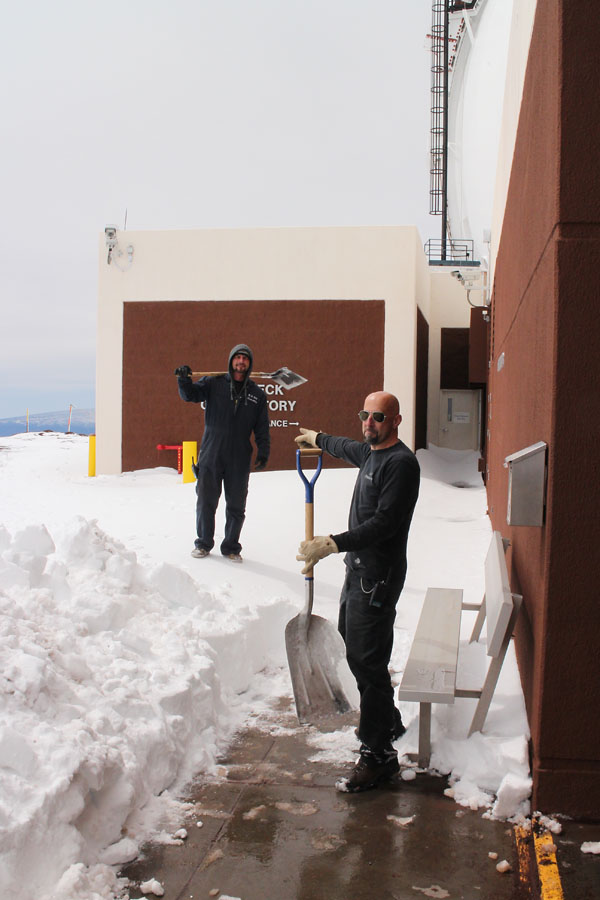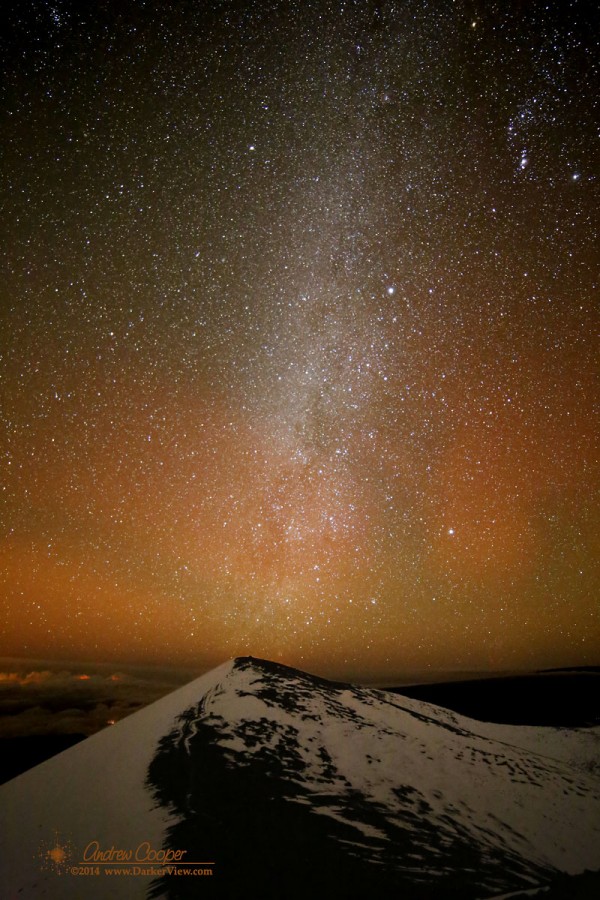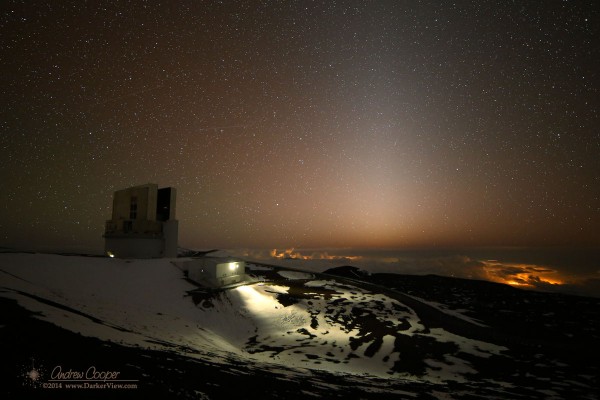
Tag: Mauna Kea
Postcard from the Summit – Sunset
A Bit of Snow in the Way
Snowy Summits
Shoveling Snow in a Tropical Paradise
I shoveled snow in Hawaiʻi today.
Not the first time I have shoveled snow here. Somehow the novelty of snow in a tropical paradise never grows old. Not that shoveling snow at nearly 14,000ft gets any easier. The weekend storm left a foot of fresh snow on the mountain. As the Monday crew never made it to the summit, it fell to those of us working Tuesday to clear out the snow for access.
It was only a foot of snow? Not too bad? The snow came with 120mph winds, stripping the slopes bare and piling a three foot deep, fifteen foot wide drift in front of our loading dock and main doors. That was going to be a chore.
We needed power. The grader was working to clear the IRTF access road just above us. As the crew moved the vehicles I made a trip up to intercept the grader. At my request the driver joking asked how much cash I had. No. Beer? No. I offered cookies and the deal was made. A few minutes later the grader was clearing much of the snowdrift in our way.
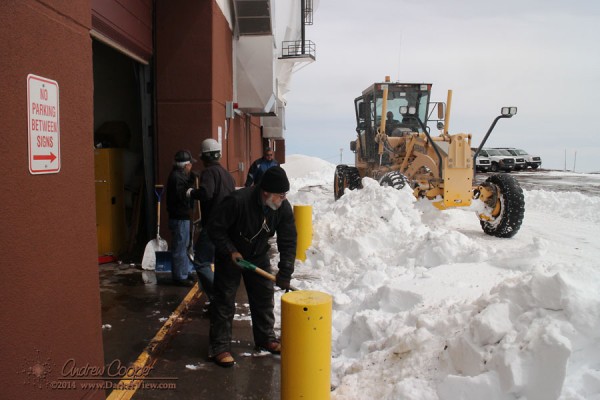
Summit and Winter Milky Way
A Night of Shooting in the Dark
The plan was to do some astrophotography Saturday night. The weather forecast forced a re-schedule, a winter storm arriving Saturday afternoon, Friday it was to be.
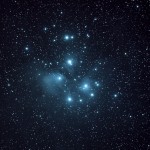
Setting up at the Mauna Kea VIS means a crowd of people. Hundreds of tourists that have come to enjoy a dark Mauna Kea Sky. I was joined by Raymond, a Hilo amateur also looking to take some photos. We setup side by side in a parking space just off the patio where the VIS was setting up their telescopes for the night. We would be in the center of the crowd for a while.
Staying Late at Work
The plan was simple. Stay on the summit after work to do some nighttime scenic photography.
I was hesitant in going up after suffering my recent ear infection. The ear is vastly better, no problems with clearing the ear for several days. After two weeks absence the list of things I needed to get done on the summit was getting lengthy and urgent. Yet I worried a bit about going up. An idea… Take my own vehicle. If I have trouble I can go at my own pace without holding up the rest of the guys. If the trouble is serious I can abort and head back down.
If I did bring my own vehicle I could get in a little photography along the way. I had not really had a chance to try out the Rokinon 14mm f/2.8 lens I had bought specifically for starry sky work. Why not stay late, watch sunset and take a few photos after dark? There is snow on the summit, the weather looked promising, the Moon would not rise until after 10pm, all good things.
The plan worked as envisioned. A good day getting stuff done. Actually a rather hectic day. The filter wheel problem of TRICK found and eliminated, the heater circuit at least looked at, I think the problem is still there. Warping data recorded for a segment in Keck 2 for the refurbishment project. Some wiring on TBAD completed, still more to do. An issue with the Keck 2 interlocks that popped up during the day was dealt with. Yes, a very good day.
A minimal dinner of instant ramen, and some paperwork accomplished while waiting for sunset.
Into the cold dark I go… The combination of the Canon 6D and the fast 14mm lens is impressive. This gear will really allow me to step up my game. I was able to shoot great material under very dark conditions. Photos that had been just out of reach for me until now. It will take me a couple days to go through and process the material, but a first look is very pleasing.
Only one problem… What is this red stuff showing up in my photos? Normal airglow is green, but this is crimson red and has very distinct structure? The idea of aurora crosses my mind, almost immediately dismissed as I am standing at 20°N latitude. I step away from the camera and the light for a bit. With some effort I can convince myself that I am seeing red in the sky, at least in the darker areas away from the Milky Way. But it is fleeting, and perhaps just an overactive desire to see something.
I get home and just out of curiosity I check the planetary Kp index… What?!? We have a Kp=6 geomagnetic storm in progress! Beautiful aurora photos are being posted from the upper midwest. Reports of aurora from across much of the United States. There is certainly a dramatic storm in progress. Perhaps this is a low latitude auroral glow!
There are some references to auroral glows detected at all latitudes during strong geomagnetic storms. Is this what my camera is detecting?
It is a nice photo. You can see the glow from the lava lake at Halemaʻumaʻu, the winter Milky Way, and a research laser shining straight up from the atmospheric lab atop Mauna Loa.

Capturing the Mountian Shadow
A high quality pan-tilt-zoom camera on the roof of the observatory at an altitude of 13,630ft? Just too much fun. I have found myself logging into the camera at sunset to enjoy the view, or keeping the video in the corner of my screen through a Hawaiian blizzard. I have even forwarded images to a local television station when they requested views of a white Christmas in Hawaiʻi. Yes, they used them for the evening news!

To make the best of this wonderful toy I need some tools. To that end several Python programs have been written, including a camera scheduler. This program takes a text file with a schedule and captures images at the programmed time and date. All of this was easy to implement in Python, all of the necessary ‘net protocol support is available in the libraries.
The schedule file can contain any number of separate schedules for multiple sequences. At the specified time the program insures the camera is set properly, moves the camera to the correct position and captures the image. Each sequence is saved to a unique directory and given a sequential name suitable for compiling time lapse video. Add a simple GUI to allow images and status to be monitored and the program becomes a very useful tool.
There are now multiple sequences running… Photos of the summit ridge at each sunset, the shadow of the GPS antenna every day at noon, the Kohala mountain every day mid-morning, the TMT construction site several times a day, and more.
Postcard from the Summit – A Very Cold Day
Getting to and from the vehicles was done as quickly as possible, running from door to door. Not only were the temperatures as low as anyone could remember, the wind was adding to the issue, blowing at a steady 35mph. The temperatures reached -8°C (17°F) at night and never rose above freezing during the day. The ice is slowly sublimating in the dry air, but there is still too much on the domes for safe observing.
Now if the wind would obey the posted speed limit…


